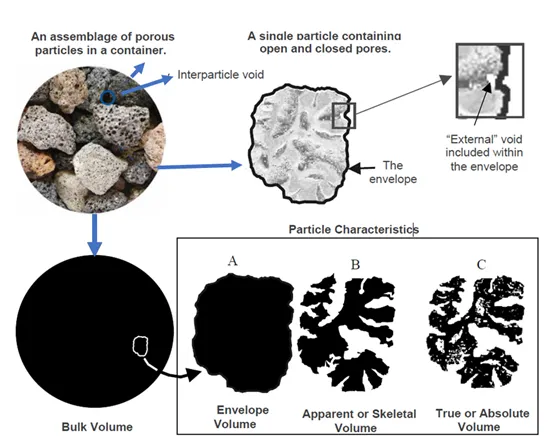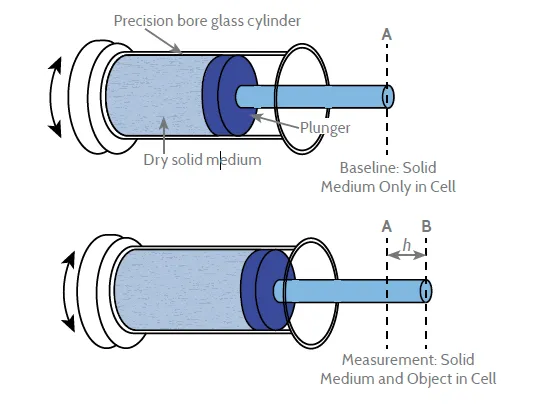Density is a crucial characteristic of powders (particles). It is widely used to evaluate the fluidity and compressibility of particles. This greatly impacts all parts of making drugs. For example, early product design depends on drug particle density. So do equipment selection and accessories. Specific drugs need the right disks and needles. They are used for filling capsules. The right guides for tablet presses also depend on the drug density. Powder density affects compressibility, hardness, and other indicators in tableting and dry granulation. Finally, during the design process, notice differences in raw materials and excipients. Also, notice the differences in granule and powder density. This is to avoid mixing and particle defects. So, the drug industry needs to study the density of powders more.
Middle school physics tells us that density measures mass at a specific volume. This concept can be represented by the symbol ρ. In the International System of Units and Chinese legal measurement units, the unit of density is kg/m³. Density is an object’s mass divided by its volume. It shows the mass to volume ratio of a substance. Density is one of the defining characteristics of matter. Each substance has a certain density. Substances generally have different densities. So, it can be used to identify them. Measuring the density of a regular, rigid substance is simple. But, measuring the density of an irregular substance has been a challenge in the past. In the middle school physics textbook, Archimedes put Hierro II’s crown in water. He then measured the density of gold using the drainage volume. Today we call this method as density measurement. It is still suitable for measuring the density of objects without voids and with holes. Today’s density measurement tech uses gas, liquid, or fine powder.
So why do we need different replacement media? This is because many substances have cracks, voids, and winding channels. These result in different “density” definitions. Each requires a different ways to measure. The first technology only measures the sample’s volume. It does not consider its pores. The second technology measures the sample’s volume and its pores. It measures both open and closed pores. The third technology also measures the sample’s pores. It also measures the gaps between samples. It can be seen as a pure solid phase.

Absolute density
Absolute density is also called true density, apparent density, or skeletal density. It does not include the pores in the bulk sample or the gaps between samples. It is the density of the pure solid phase sample. Until now, we got the sample’s volume by filling its pores with water or other liquids to empty them. Then, we found its density. Sometimes, to fill pores, the object is placed in the liquid and boiled. Or, the object is emptied before being placed in the liquid. But, the surface tension and gas in the pores resist filling them with liquid.
Liquid density measurement tech has disadvantages. So, the industry uses helium (or other gases) density meters. Compared to liquid densitometers, gas densitometers are simpler, faster, more accurate, and repeatable. Gas densitometers are a non-destructive technique for measuring the density of materials. They use gas displacement to measure an object’s true volume. This makes them ideal for finding an object’s true density. We only need to seal a known-weight sample in the chamber. Then, we keep it at a constant temperature by using a helium densitometer. Helium is then added to the system. The pressure in the sample chamber of the helium densitometer reaches equilibrium. Since helium is a small molecule, it can penetrate into the pores of the sample. The helium in the sample chamber is then released into the expansion chamber. The pressure evens out again. The volume of the sample is calculated using equilibrium pressure and the gas law. Finally, the pressure is released from the system and the sample is removed. So, the object’s absolute density is measured with a helium density meter. This type of density is also called “helium density”.
Envelope density

Inclusion density is the density of a porous object’s pore volume. It’s sometimes called bulk density, but I think that’s not very accurate. When considering the sample volume, picture a thin film on the sample’s surface. The “inclusion volume” is the volume wrapped in the film.
The meter measures the volume of inclusions. It uses the dry powder method. This dry powder is a rigid sphere with uniform particle size and excellent fluidity. It can tightly wrap the object and does not react to it. The dry powder’s small size ensures it sticks to the object’s surface and does not enter its pores. This method does not harm the measured object or make it dirty. The measurement is fast and simple.
The dry powder is placed is a precise cylinder. A piston is located in the sample chamber for compression. The force can be set and used again. First, only dry powder is used for compression in the sample chamber to obtain a zero volume baseline. Then, the object to be measured, and the dry powder is placed in the sample chamber together. The above compression is repeated to find the piston’s displacement. Then, the volume of the object to be measured can be found. It’s based on the bottom area of the sample chamber (the cylinder’s circular bottom). Finally, after shaking and dust removal, the dry powder on the sample can be removed. Then, the sample can be restored to its original state and the test can be repeated. You can select the sample chamber in different sizes. The object’s size is chosen based on its size. This meets the requirements for measurement.
A porous object’s inclusion density is less than its absolute density. For a non-porous object, its inclusion density equals its absolute density. So, by measuring the absolute and inclusion density of one object, we can find its total porosity. To get a zero volume baseline, we only use dry powder for compression in the sample chamber.
Bulk density & Tap density
The Chinese Pharmacopoeia 2020 Edition Part Four General Rules 0993 introduces the bulk density and tap density methods. The pharmacopoeia defines bulk density as the density. It is measured when a drug or excipient powder is filled. It is in a loose state. Loose state refers to a state formed by pouring a powder sample into a container. This was done without compression. Bulk density is the mass of powder per unit volume. The powder fills a specified container. How the sample is prepared, processed, and stored affects the bulk density value. It is tied to the disposal process. Different particle arrangements can cause the bulk density to vary within a range. Even slight changes may affect bulk density. The results are not highly reproducible. So, report the measurement conditions when reporting the bulk density. Bulk density can be found by measuring the volume of a certain mass of powder. This is done in a measuring cylinder after sifting (the first method). Or, by using a volumeter for determination (the second method). Or, you can measure the mass of the powder after sifting. Then, fill a container with a certain volume (third method).
Tap density refers to the filling density of the powder in the tapped state. The tapped state is the state of the powder column. The powder sample is in the container. It vibrates downward at a certain frequency until the volume no longer changes. The device causes vibrations by lifting the cup and letting it fall. It falls at a fixed distance due to gravity. The tapped density can be found by measuring the tapped volume of a fixed mass sample. This is done using either the first or second method. Or, you can find it by weighing the sample after it has been tapped in a known volume measuring vessel. This is the third method.
The way particles interact affects powder stacking. This also affects the powder flow. The difference between bulk density and tapped density is key. This shows how powder particles interact. It also measures powder flowability. It does this with the compressibility index or Hausner ratio.
